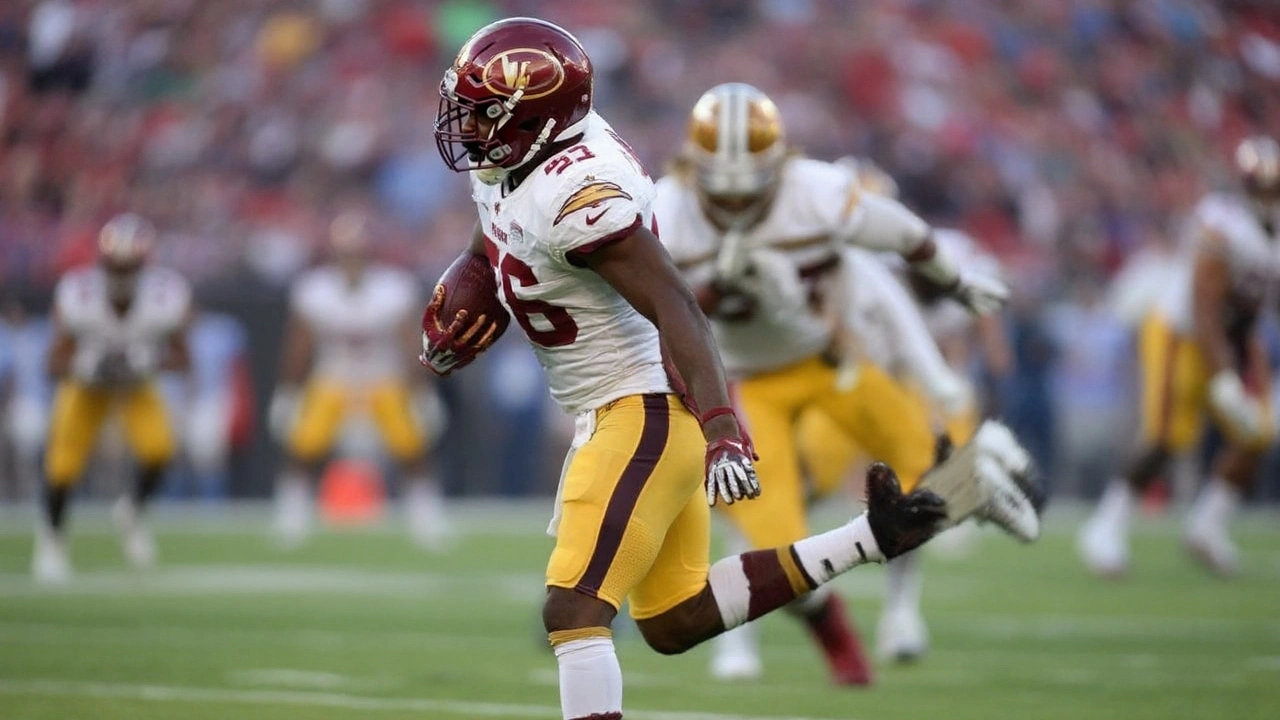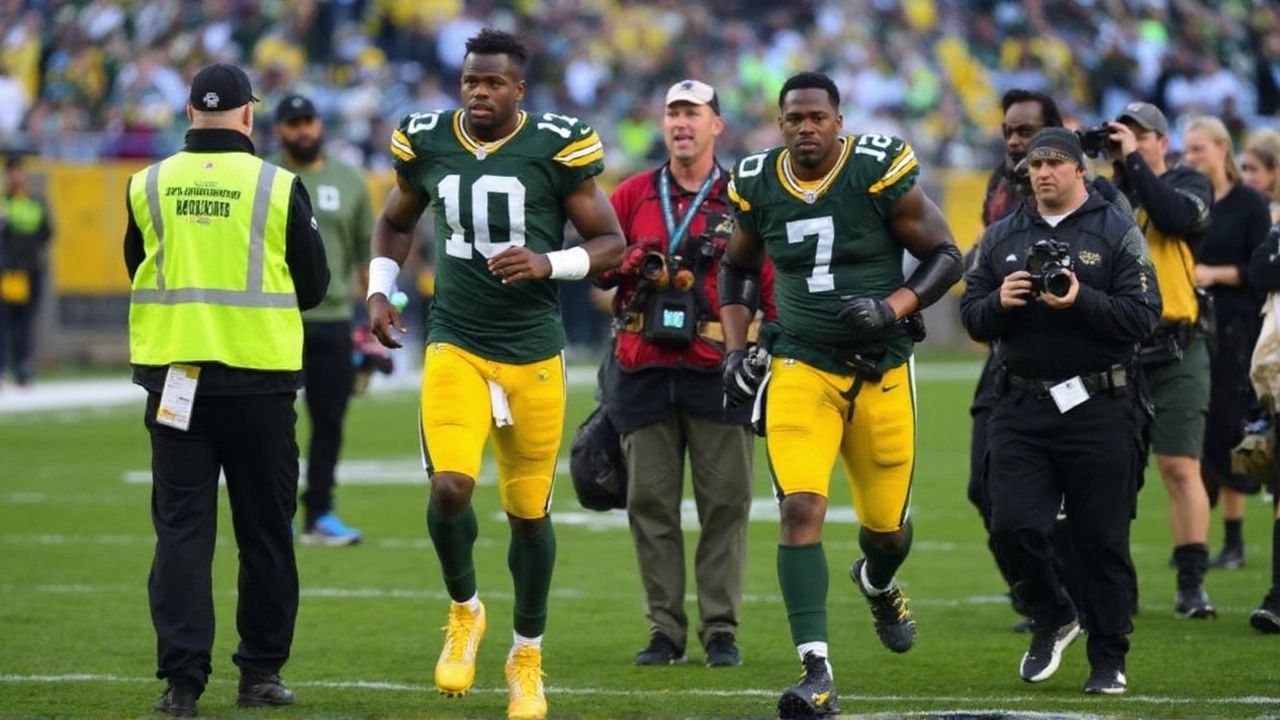What’s at stake on Thursday night
There’s no easing into Week 2. Under the lights at Lambeau Field, Packers vs Commanders has the feel of a measuring-stick game for two teams that opened the season throwing punches, not jabs. The betting market has noticed. Green Bay moved from a 1.5-point favorite on the lookahead to -3 by midweek, with a total sitting at 48.5, signaling confidence in the Packers’ defense holding serve at home.
Both teams arrive with clean Week 1 wins and a clear identity. Washington bullied the New York Giants 21-6 behind a ground game that piled up 220 rushing yards and a defense that slammed the door in tight spaces. Jayden Daniels looked comfortable steering a run-first offense, and rookie back Jacory “Bill” Croskey-Merritt ripped off 82 yards on just 10 carries, giving Washington another downhill option to pair with its quarterback’s dual-threat spark.
Green Bay’s opener was just as convincing. The Packers handled the Detroit Lions 27-13, playing the kind of balanced, stress-free football coaches crave in September. Jordan Love was efficient, the pass rush was relentless, and the retooled roster flashed right away. The debut of Josh Jacobs added a punishing element to the backfield, while the arrival of Micah Parsons on defense gave Green Bay raw speed and chaos off the edge. The Lions finished with only 50 rushing yards, and most drives felt like a hike into a headwind.
That’s the lever that could decide Thursday night: can Washington’s sledgehammer run game break Green Bay’s new-look front? Under Daniels, the Commanders are 9-0 (including playoffs) when they hit 150 rushing yards, and they finished third in the league in rushing last year. This offense doesn’t hide what it wants to do. It leans into zone read, RPOs, motion, and misdirection—forcing defenses to play both sides of the board on every snap. When Washington is ahead of the sticks, it turns games into long, bruising drives that shrink the clock and sap pass rushers.
Green Bay won’t concede that rhythm. The plan from the Packers’ defensive brain trust is straightforward: keep Daniels in the pocket, fit the run without overcommitting, and force him to stack throws on third-and-medium. With Parsons in the fold, Green Bay can get to mobile quarterbacks with athleticism rather than constant blitzes. Expect a healthy dose of edge containment, a spy at times, and interior gap discipline to erase the cutback lanes Washington typically exploits.
The history adds a layer of intrigue. The Packers lead the all-time series 22-17-1, but Washington took their most recent meeting in 2023. The Commanders haven’t won in Green Bay since 1986, a ghost of a streak that spans almost four decades. That won’t decide Thursday, of course, but Lambeau does tilt the field—especially for a team trying to hammer out first downs on the ground in long-march fashion.
The stakes go beyond a single week. Washington is coming off a 12-5 season and a run to the NFC Championship Game, falling short against Philadelphia. Green Bay finished 11-6 before a Wild Card exit left the locker room with the nagging feeling of unfinished business. This is the kind of game that shapes tone: for Washington, proof that last year’s surge wasn’t a blip; for Green Bay, a statement that its defense and quarterback are ready to elevate from good to dangerous.
Injuries could nudge the chessboard. The Packers’ offensive line is dinged up, and any instability there cascades into protection calls, play-action timing, and the ground game’s interior push. Washington’s front will test that immediately with movement and stunts. If the Packers settle protections early, their playbook opens. If they don’t, the Packers will have to live off quick answers and backs chipping on the way out.

Matchups, tactics, and betting edges
Start with Washington’s offense. The Commanders want five- and six-yard body blows, not haymakers, until a safety blinks. Daniels is the accelerator, but the engine is the run game. When Washington can run zone and sweep with the same backfield action, linebackers freeze and the RPO slants start landing. That’s where the Commanders flip from plodding to punishing: 10-play drives that end with bruises and points.
Green Bay’s answer is speed and discipline. Parsons changes spacing. The Packers can set harder edges without selling out, which is crucial against a quarterback who punishes over-pursuit. Look for Green Bay to play with split-safety shells pre-snap, then rotate late to muddy Daniels’ reads. Expect a handful of simulated pressures—show blitz with linebackers, send a rusher from elsewhere—to coax quick, horizontal throws and rally to tackle.
Key detail: Washington’s run game is most dangerous on early downs. If the Packers steal first down with a run stuff or a negative play, the second-and-long math flips. Daniels is improving as a pocket passer, but Washington’s offense is built to avoid obvious passing downs. Green Bay’s best chance is to keep second down “off schedule” and make Washington chase yardage instead of dictating it.
Flip it around. Jordan Love operated with poise in Week 1, using motion and play-action to create space in the middle of the field. When Love is on time, Matt LaFleur’s system stretches defenses horizontally and forces safeties into uncomfortable choices. Jacobs adds another layer: he’s a finisher on inside zone and a hammer in short yardage, and he can set the tenor when Green Bay wants to slow the game and lean on Washington’s front.
Washington’s defense prides itself on denying the end zone, and the opener backed that up with stout goal-line stands. The Commanders use disguise to bait quarterbacks into late throws, then close quickly on the ball. They’ll test Green Bay’s protection rules with creepers and late rotation. If the Packers’ line is patchwork on Thursday, you’ll see more quick game—slants, sticks, and screens—to keep Love’s jersey clean and temper the pass rush.
Hidden factors will creep in, as they always do at Lambeau. Cadence is a weapon here, and crowd noise can steal five yards on third-and-manageable with a false start. Field position swings on special teams often decide these prime-time grinders. One short punt, one coverage bust, and a defensive battle turns into a two-score lull that’s tough to escape when both defenses travel.
A few pivot points to watch:
- Early-down efficiency. If Washington averages 4.5+ yards on first down, its playbook hums. If Green Bay forces second-and-8, the Commanders lose their favorite calls.
- Explosive plays. Washington wants to avoid volatility; Green Bay needs a handful of 20+ yard gains to get Washington out of its comfort zone.
- Red-zone decisions. Both staffs have leaned aggressive on fourth-and-short. A single go-for-it call could swing expected points by a full score.
- QB hits. Keep an eye on how often Daniels and Love get touched. Mobility helps, but hits add up in the fourth quarter.
On the betting board, the market has drawn a line in the sand. Packers -3 (with some shops flirting with -3.5) suggests home-field plus a small edge on the lines of scrimmage. If you’re backing Green Bay, you’re essentially betting the Packers can set the edges, win first down on defense, and keep Love in manageable passing downs with Jacobs balancing the script.
If you like Washington and the points, your case is straightforward: the Commanders’ run game travels, Daniels creates two or three chain-moving plays per drive with his legs, and Washington’s defense forces field goals, not touchdowns. That profile keeps games inside a field goal and sets the table for late-game variance—a tipped pass, a kick from 52 in cold air, one slip on a comeback route.
The total at 48.5 has drawn interest on the under. The logic is clean: both defenses can control tempo, and both offenses are content to turn this into a possession game if the other side blinks first. An under script would look like 10+ play drives, red-zone resistance, and a fourth quarter where every snap feels like a swing moment. An over script likely needs defensive busts or short fields off turnovers.
Prop-wise, the early spotlight is on Jacobs. His anytime touchdown is popular, given his short-yardage role and Green Bay’s willingness to tilt run-heavy inside the 10. There’s also under action on his receiving yards at 11.5, a nod to pass protection needs if the Packers are thin up front and to a game plan that keeps him between the tackles. Daniels’ rushing usage will be a live topic, too; even without a posted number here, how often he keeps on zone read will say a lot about Washington’s comfort with the matchup.
Coaching choices will matter. Washington wants a low-variance structure—punt on fourth-and-medium around midfield, trust the defense, and let the ground game wear on a front seven over time. Green Bay, at home, can be more willing to chase momentum. Expect LaFleur to script shot plays off run looks in the first 15 snaps, hunting a quick haymaker to tilt the coverage picture.
Personnel puzzles will surface during the game. If Green Bay’s tackles struggle, watch for tight ends chipped in protection and more two-back looks to mess with Washington’s run fits. If Washington’s guards can reset the line of scrimmage, expect a heavier diet of counter and GT pull to target flowing linebackers. And if Parsons starts taking the game over, the Commanders will force him to read—option at him, screen behind him, make him think before he accelerates.
Situational football often decides these prime-time games. Third-and-3 to -5 is the money down: Washington wants to run or throw quick RPO slants; Green Bay wants to force throws outside the numbers. In the red zone, watch how Washington handles condensed windows—can Daniels find crossers and high-lows against tight coverage, or does the field shrink too fast? For Green Bay, Love’s placement on seam and glance routes will show whether the Commanders can crowd the box without getting punished behind them.
Forecast-wise, an early-September night at Lambeau usually means a cool track and clean footing—good news for a game built on leverage and cuts. Kicking should be trustworthy, which subtly favors a team like Green Bay that can pile field goals while the defense drags drives to a halt. It also keeps Washington live to grind its way into scoring range and ask its kicker to cash in long possessions.
So where does that leave the predictions? The expert lean is Green Bay to cover the field-goal spread at home, with confidence buoyed by the Week 1 defensive tape and the crowd’s effect on Washington’s cadence. The under has real backers at 48.5, tied to an expectation of sustained drives and red-zone resistance. The Washington path is as clear as it is demanding: own first down, break 150 rushing yards, limit explosive passes, and make this a fourth-quarter coin flip.
Kickoff is set for 8:15 p.m. ET on Thursday, September 11. For an early-season game, the signal is louder than the calendar suggests. If Washington proves its run game plays anywhere, the NFC picture tightens. If Green Bay’s defense keeps stacking stops, Lambeau starts to feel like a venue, not just a location.
